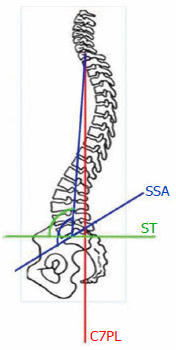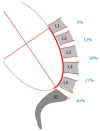Current strategies for the restoration of adequate lordosis during lumbar fusion
- PMID: 25621216
- PMCID: PMC4303780
- DOI: 10.5312/wjo.v6.i1.117
Current strategies for the restoration of adequate lordosis during lumbar fusion
Abstract
Not restoring the adequate lumbar lordosis during lumbar fusion surgery may result in mechanical low back pain, sagittal unbalance and adjacent segment degeneration. The objective of this work is to describe the current strategies and concepts for restoration of adequate lordosis during fusion surgery. Theoretical lordosis can be evaluated from the measurement of the pelvic incidence and from the analysis of spatial organization of the lumbar spine with 2/3 of the lordosis given by the L4-S1 segment and 85% by the L3-S1 segment. Technical aspects involve patient positioning on the operating table, release maneuvers, type of instrumentation used (rod, screw-rod connection, interbody cages), surgical sequence and the overall surgical strategy. Spinal osteotomies may be required in case of fixed kyphotic spine. AP combined surgery is particularly efficient in restoring lordosis at L5-S1 level and should be recommended. Finally, not one but several strategies may be used to achieve the need for restoration of adequate lordosis during fusion surgery.
Keywords: Lumbar lordosis; Pelvis incidence; Pelvis shape; Sagittal balance; Spinal fusion; Spine surgery.
Figures











References
-
- Doherty J. Complications of fusion in lumbar scoliosis. Proc Scoliosis Res Soc. 1973;55:438–45.
-
- Moe JH, Denis F. The iatrogenic loss of lumbar lordosis. Orthop Trans. 1977;1:131.
-
- Swank S, Lonstein JE, Moe JH, Winter RB, Bradford DS. Surgical treatment of adult scoliosis. A review of two hundred and twenty-two cases. J Bone Joint Surg Am. 1981;63:268–287. - PubMed
-
- Swank SM, Mauri TM, Brown JC. The lumbar lordosis below Harrington instrumentation for scoliosis. Spine (Phila Pa 1976) 1990;15:181–186. - PubMed
-
- Lagrone MO, Bradford DS, Moe JH, Lonstein JE, Winter RB, Ogilvie JW. Treatment of symptomatic flatback after spinal fusion. J Bone Joint Surg Am. 1988;70:569–580. - PubMed
Publication types
LinkOut - more resources
Full Text Sources
Other Literature Sources
Medical

